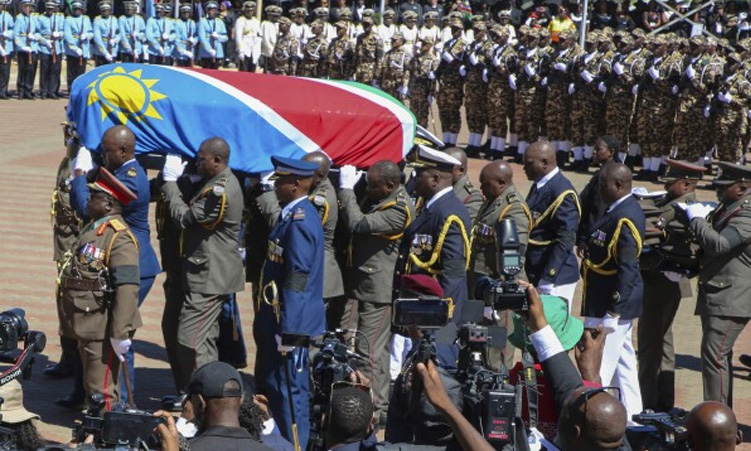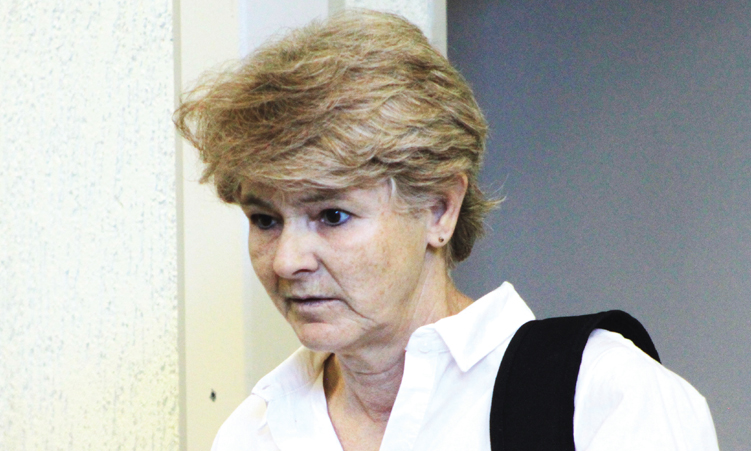LAST week’s oil spill in the Walvis Bay harbour was cleaned up before the weekend, but the source of the pollution is still unknown.
The detection of heavy fuel oil at berth 6 on Wednesday afternoon set the emergency procedure of Namport’s Safety, Health, Environment, Risk and Quality Department (SHERQ) in motion. Booms were deployed to restrict the pollution to one area and bags of oil-absorbent material called Ecoserve were floated to sponge up the contaminants.According to Namport spokesperson Jerome Mouton, the affected area is no larger than ten metres in diameter.”Though the spill is not considered as serious, we don’t treat any [such cases] as insignificant,” he said.The oil was noticed around the vessel Sierra Cazorla, but divers reported that no signs were found on the vessel’s hull to indicate that it was the source of the spill.Mouton told The Namibian that samples of the oil were sent to a laboratory in South Africa for a “fingerprint analysis”.The results are expected early this week.— Seven Spanish fire engines for Namibia’s airports * ELMA ROBBERTS NAMIBIA moved closer to international standards for airport safety with the donation of seven firefighting vehicles to the Ministry of Works, Transport and Communication.Deputy Works Minister Stefanus Mogotsi last week received the keys to six of the rescue vehicles from the Contract Manager of the Ineco-Page-Defex Spanish Consortium (INEPADE), Enrique Perez Diaz.The seventh vehicle is already operational at the Hosea Kutako International Airport.The handover ceremony at the Walvis Bay Airport marked the fulfilment of one section of a Namibian-Spanish co-operation programme signed between the two governments in July 2001.In terms of the programme, Spain made available 55 million euros for financing mutually accepted projects which will be carried out by Spanish firms.Approximately 32 million euros of the total amount was set aside for the rehabilitation and upgrading of Namibia’s airports and air-traffic control systems.The Namibian Government is responsible for the costs of local levies and taxes, supervision and management of the project and any expenses exceeding the amount provided by Spain.In October 2002, the International Air Transport Association (IATA) declared Namibia’s air transportation infrastructure and control systems to be critically deficient.”This project will …correct those deficiencies in providing the Directorate Civil Aviation and the Namibia Airports Company with up-to-date equipment and systems,” Mogotsi said.Meanwhile, the upgrading of the Walvis Bay Airport, which is part of the co-operation programme, has been put on hold.Improvements to the tune of N$256 million, including the lengthening and widening of the runway, a top-of-the-range landing system, new taxiway and runway lights, were agreed on in 2004.These improvements will allow the Walvis Bay Airport to accommodate large aircraft such as the Airbus 380 and the Boeing 747.The Minister ascribed the delay to financial and technical issues on the side of INEPADE.”The parties are currently looking into the problems, which in my opinion are not attributable to the Ministry and its agents.The Government of Namibia is very disturbed by these events which, if not resolved, will have a major impact on its development objectives,” said Mogotsi.”I trust that the construction work will restart soonest.”Three of the new fire trucks will operate at Hosea Kutako International Airport, three will remain at Walvis Bay and one will be sent to the Ondangwa Airport.The vehicles were manufactured by the Spanish company Protec Fire.The largest boasts a 950-horsepower Caterpillar engine, a 12 000-litre water tank and 1 600-litre foam tank.According to Defex SA Commercial Director Manuel Iglesias-Sarria, the vehicles are perfectly adapted to local requirements and function in accordance with international safety regulations.Booms were deployed to restrict the pollution to one area and bags of oil-absorbent material called Ecoserve were floated to sponge up the contaminants.According to Namport spokesperson Jerome Mouton, the affected area is no larger than ten metres in diameter.”Though the spill is not considered as serious, we don’t treat any [such cases] as insignificant,” he said.The oil was noticed around the vessel Sierra Cazorla, but divers reported that no signs were found on the vessel’s hull to indicate that it was the source of the spill.Mouton told The Namibian that samples of the oil were sent to a laboratory in South Africa for a “fingerprint analysis”.The results are expected early this week. — Seven Spanish fire engines for Namibia’s airports * ELMA ROBBERTS NAMIBIA moved closer to international standards for airport safety with the donation of seven firefighting vehicles to the Ministry of Works, Transport and Communication.Deputy Works Minister Stefanus Mogotsi last week received the keys to six of the rescue vehicles from the Contract Manager of the Ineco-Page-Defex Spanish Consortium (INEPADE), Enrique Perez Diaz.The seventh vehicle is already operational at the Hosea Kutako International Airport.The handover ceremony at the Walvis Bay Airport marked the fulfilment of one section of a Namibian-Spanish co-operation programme signed between the two governments in July 2001.In terms of the programme, Spain made available 55 million euros for financing mutually accepted projects which will be carried out by Spanish firms.Approximately 32 million euros of the total amount was set aside for the rehabilitation and upgrading of Namibia’s airports and air-traffic control systems.The Namibian Government is responsible for the costs of local levies and taxes, supervision and management of the project and any expenses exceeding the amount provided by Spain.In October 2002, the International Air Transport Association (IATA) declared Namibia’s air transportation infrastructure and control systems to be critically deficient.”This project will …correct those deficiencies in providing the Directorate Civil Aviation and the Namibia Airports Company with up-to-date equipment and systems,” Mogotsi said.Meanwhile, the upgrading of the Walvis Bay Airport, which is part of the co-operation programme, has been put on hold.Improvements to the tune of N$256 million, including the lengthening and widening of the runway, a top-of-the-range landing system, new taxiway and runway lights, were agreed on in 2004.These improvements will allow the Walvis Bay Airport to accommodate large aircraft such as the Airbus 380 and the Boeing 747.The Minister ascribed the delay to financial and technical issues on the side of INEPADE.”The parties are currently looking into the problems, which in my opinion are not attributable to the Ministry and its agents.The Government of Namibia is very disturbed by these events which, if not resolved, will have a major impact on its development objectives,” said Mogotsi.”I trust that the construction work will restart soonest.”Three of the new fire trucks will operate at Hosea Kutako International Airport, three will remain at Walvis Bay and one will be sent to the Ondangwa Airport.The vehicles were manufactured by the Spanish company Protec Fire.The largest boasts a 950-horsepower Caterpillar engine, a 12 000-litre water tank and 1 600-litre foam tank.According to Defex SA Commercial Director Manuel Iglesias-Sarria, the vehicles are perfectly adapted to local requirements and function in accordance with international safety regulations.
Stay informed with The Namibian – your source for credible journalism. Get in-depth reporting and opinions for
only N$85 a month. Invest in journalism, invest in democracy –
Subscribe Now!










